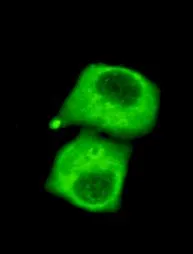Pyruvate Dehydrogenase E1 alpha antibody
GTX104015
ApplicationsImmunoFluorescence, ImmunoPrecipitation, Western Blot, ImmunoCytoChemistry, ImmunoHistoChemistry, ImmunoHistoChemistry Paraffin
Product group Antibodies
TargetPDHA1
Overview
- SupplierGeneTex
- Product NamePyruvate Dehydrogenase E1 alpha antibody
- Delivery Days Customer9
- Application Supplier NoteWB: 1:500-1:10000. ICC/IF: 1:100-1:1000. IHC-P: 1:100-1:1000. IP: 1:100-1:500. *Optimal dilutions/concentrations should be determined by the researcher.Not tested in other applications.
- ApplicationsImmunoFluorescence, ImmunoPrecipitation, Western Blot, ImmunoCytoChemistry, ImmunoHistoChemistry, ImmunoHistoChemistry Paraffin
- CertificationResearch Use Only
- ClonalityPolyclonal
- Concentration1.39 mg/ml
- ConjugateUnconjugated
- Gene ID5160
- Target namePDHA1
- Target descriptionpyruvate dehydrogenase E1 subunit alpha 1
- Target synonymsE1alpha, PDHA, PDHAD, PDHCE1A, PHE1A, pyruvate dehydrogenase E1 component subunit alpha, somatic form, mitochondrial, PDHE1-A type I, pyruvate dehydrogenase (lipoamide) alpha 1, pyruvate dehydrogenase E1 alpha 1 subunit, pyruvate dehydrogenase alpha 1, pyruvate dehydrogenase complex, E1-alpha polypeptide 1
- HostRabbit
- IsotypeIgG
- Protein IDP08559
- Protein NamePyruvate dehydrogenase E1 component subunit alpha, somatic form, mitochondrial
- Scientific DescriptionThe pyruvate dehydrogenase complex is a nuclear-encoded mitochondrial matrix multienzyme complex that provides the primary link between glycolysis and the tricarboxylic acid (TCA) cycle by catalyzing the irreversible conversion of pyruvate into acetyl-CoA. The PDH complex is composed of multiple copies of 3 enzymes: E1 (PDHA1); dihydrolipoyl transacetylase (DLAT; MIM 608770) (E2; EC 2.3.1.12); and dihydrolipoyl dehydrogenase (DLD; MIM 238331) (E3; EC 1.8.1.4). The E1 enzyme is a heterotetramer of 2 alpha and 2 beta subunits. The E1-alpha subunit contains the E1 active site and plays a key role in the function of the PDH complex (Brown et al., 1994 [PubMed 7853374]).[supplied by OMIM]
- Storage Instruction-20°C or -80°C,2°C to 8°C
- UNSPSC12352203
References
- MacLeod CM, Yousufzai FAK, Spencer LT, et al. Trehalose enhances mitochondria deficits in human NPC1 mutant fibroblasts but disrupts mouse Purkinje cell dendritic growth ex vivo. PLoS One. 2023,18(11):e0294312. doi: 10.1371/journal.pone.0294312Read this paper
- Kim S, Ochoa K, Melli SE, et al. Disruptive lysosomal-metabolic signaling and neurodevelopmental deficits that precede Purkinje cell loss in a mouse model of Niemann-Pick Type-C disease. Sci Rep. 2023,13(1):5665. doi: 10.1038/s41598-023-32971-0Read this paper
- Kirova DG, Judasova K, Vorhauser J, et al. A ROS-dependent mechanism promotes CDK2 phosphorylation to drive progression through S phase. Dev Cell. 2022,57(14):1712-1727.e9. doi: 10.1016/j.devcel.2022.06.008Read this paper
- Rosina M, Ceci V, Turchi R, et al. Ejection of damaged mitochondria and their removal by macrophages ensure efficient thermogenesis in brown adipose tissue. Cell Metab. 2022,34(4):533-548.e12. doi: 10.1016/j.cmet.2022.02.016Read this paper
- Zhang R, Shen W, Du J, et al. Selective knockdown of hexokinase 2 in rods leads to age-related photoreceptor degeneration and retinal metabolic remodeling. Cell Death Dis. 2020,11(10):885. doi: 10.1038/s41419-020-03103-7Read this paper
- Rey T, Zaganelli S, Cuillery E, et al. Mitochondrial RNA granules are fluid condensates positioned by membrane dynamics. Nat Cell Biol. 2020,22(10):1180-1186. doi: 10.1038/s41556-020-00584-8Read this paper
- Jonus HC, Byrnes CC, Kim J, et al. Thiamine mimetics sulbutiamine and benfotiamine as a nutraceutical approach to anticancer therapy. Biomed Pharmacother. 2020,121:109648. doi: 10.1016/j.biopha.2019.109648Read this paper
- Chen Y, Chernyavsky A, Webber RJ, et al. Critical Role of the Neonatal Fc Receptor (FcRn) in the Pathogenic Action of Antimitochondrial Autoantibodies Synergizing with Anti-desmoglein Autoantibodies in Pemphigus Vulgaris. J Biol Chem. 2015,290(39):23826-37. doi: 10.1074/jbc.M115.668061Read this paper
- Deng W, Leu HB, Chen Y, et al. Protein kinase B (PKB/AKT1) formed signaling complexes with mitochondrial proteins and prevented glycolytic energy dysfunction in cultured cardiomyocytes during ischemia-reperfusion injury. Endocrinology. 2014,155(5):1618-28. doi: 10.1210/en.2013-1817Read this paper
- Chao LC, Wroblewski K, Ilkayeva OR, et al. Skeletal muscle Nur77 expression enhances oxidative metabolism and substrate utilization. J Lipid Res. 2012,53(12):2610-9. doi: 10.1194/jlr.M029355Read this paper



![Untreated (-) and treated (+) 293T whole cell extracts (30 microg) were separated by 10% SDS-PAGE, and the membrane was blotted with Pyruvate Dehydrogenase E1 alpha (phospho Ser293) antibody [GT1301] (GTX03213) diluted at 1:500. The HRP-conjugated anti-rabbit IgG antibody (GTX213110-01) was used to detect the primary antibody.](https://www.genetex.com/upload/website/prouct_img/normal/GTX03213/GTX03213_4000001567_20210716_WB_CIP_w_23053123_870.webp)


